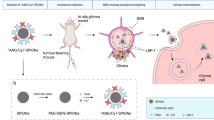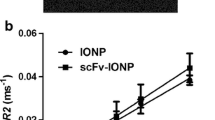Abstract
The extracellular glycoprotein Tenascin-C (TN-C) is highly upregulated in gliomas. Therefore, many chemotherapies with radiolabeled antibodies against TN-C have been performed. However, TN-Cs binding partner Syndecan-4 did not play any role as a therapeutic or imaging target in gliomas. We constructed an imaging compound containing the magnetic resonance imaging (MRI) contrast agent gadolinium (Gd)-1,4,7,10-tetraazacyclododecane-1,4,7,10-tetraacetic acid (DOTA), the fluorescence dye sulforhodamine and a synthetic Syndecan-4-specific 21 amino acid peptide derived from TN-C. Magnetic resonance relaxometry, confocal laser scanning microscopy, and flow cytometry showed that the Syndecan-4-DOTA-Rhodamine conjugate was taken up into the cytoplasm of human U373 glioma cells without any cytotoxic effects. Competition experiments indicate that this uptake was receptor-mediated. This conjugate might be used for future MRI studies of brain tumors after systemic or intraoperative local application.



Similar content being viewed by others
References
Huang W, Chiquet-Ehrismann R, Moyano JV, Garcia-Pardo A, Orend G (2001) Interference of tenascin-C with Syndecan-4 binding to fibronectin blocks cell adhesion and stimulates tumor cell proliferation. Cancer Res 61:8586–8594
Lukes I, Kotek J, Vojtisek P, Hermann P (2001) Complexes of tetraazacycles bearing methylphosphinic/phosphonic acid pendant arms with copper(II), zinc(II) and lanthanides(III) A comparison with their acetic acid analogues. Coord Chem Rev 216:287–312
Reardon DA, Zalutsky MR, Bigner DD (2007) Antitenascin-C monoclonal antibody radioimmunotherapy for malignant glioma patients. Expert Rev Anticancer Ther 7:675–687
Reardon DA, Zalutsky MR, Akabani G, Coleman RE, Friedman AH, Herndon JE 2nd, McLendon RE, Pegram CN, Quinn JA, Rich JN, Vredenburgh JJ, Desjardins A, Guruangan S, Boulton S, Raynor RH, Dowell JM, Wong TZ, Zhao XG, Friedman HS, Bigner DD (2008) A pilot study: 131I-antitenascin monoclonal antibody 81c6 to deliver a 44-Gy resection cavity boost. Neuro Oncol 10:182–189
Saito Y, Imazeki H, Miura S, Yoshimura T, Okutsu H, Harada Y, Ohwaki T, Nagao O, Kamiya S, Hayashi R, Kodama H, Handa H, Yoshida T, Fukai F (2007) A peptide derived from tenascin-C induces beta1 integrin activation through Syndecan-4. J Biol Chem 282:34929–34937
Saito Y, Shiota Y, Nishisaka M, Owaki T, Shimamura M, Fukai F (2008) Inhibition of angiogenesis by a tenascin-c peptide which is capable of activating beta1-integrins. Biol Pharm Bull 31:1003–1007
Sarkar S, Nuttall RK, Liu S, Edwards DR, Yong VW (2006) Tenascin-C stimulates glioma cell invasion through matrix metalloproteinase-12. Cancer Res 66:11771–11780
Su G, Meyer K, Nandini CD, Qiao D, Salamat S, Friedl A (2006) Glypican-1 is frequently overexpressed in human gliomas and enhances FGF-2 signaling in glioma cells. Am J Pathol 168:2014–2026
Tkachenko E, Lutgens E, Stan RV, Simons M (2004) Fibroblast growth factor 2 endocytosis in endothelial cells proceed via Syndecan-4-dependent activation of Rac1 and a Cdc42-dependent macropinocytic pathway. J Cell Sci 117:3189–3199
Watanabe A, Mabuchi T, Satoh E, Furuya K, Zhang L, Maeda S, Naganuma H (2006) Expression of syndecans, a heparan sulfate proteoglycan, in malignant gliomas: participation of nuclear factor-kappaB in upregulation of syndecan-1 expression. J Neurooncol 77:25–32
Zalutsky MR, Reardon DA, Akabani G, Coleman RE, Friedman AH, Friedman HS, McLendon RE, Wong TZ, Bigner DD (2008) Clinical experience with alpha-particle emitting 211At: treatment of recurrent brain tumor patients with 211At-labeled chimeric antitenascin monoclonal antibody 81C6. J Nucl Med 49:30–38
Acknowledgments
This study is supported by the Interdisciplinary Center for Clinical Research, University of Tübingen and the Hertie Foundation for Brain Research.
Author information
Authors and Affiliations
Corresponding authors
Rights and permissions
About this article
Cite this article
Sturzu, A., Kalbacher, H., Echner, H. et al. Imaging of human glioma cells by means of a Syndecan-4 directed DOTA-conjugate. Amino Acids 38, 1415–1421 (2010). https://doi.org/10.1007/s00726-009-0345-5
Received:
Accepted:
Published:
Issue Date:
DOI: https://doi.org/10.1007/s00726-009-0345-5




